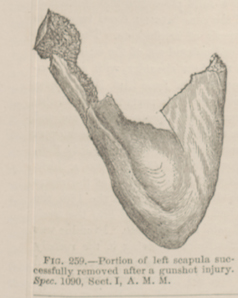Title: Bickett, F. E.
Source text: Surgeon General Joseph K. Barnes, United States Army, The Medical and Surgical History of the War of the Rebellion. (1861–65.), Part 1, Volume 2 (Washington, D.C.: Government Printing Office, 1870), 562.
Civil War Washington ID: med.d1e20035
TEI/XML: med.d1e20035.xml
CASE 1.—Private F. E. Bickett, Co. F, 5th Connecticut Volunteers, aged 51 years, was wounded at Chancellorsville, Virginia, May 3d, 1863, by a conoidal ball, which struck the infra-spinatus fossa of the left scapula about midway between its inferior angle and the spine, passed forward, splintered the bone extensively, and finally lodged in the glenoid cavity without injuring the humerus. He was treated in the field hospital of the 1st division, Twelfth Corps, until the 6th, when he was sent to Lincoln Hospital, Washington. An operation, for the removal of the ball, discovered a large number of shattered fragments lying near the joint, which were dissected out from their ligamentous attachment and withdrawn. The lower portion of the scapula being now entirely separated from the upper, and, not knowing to what extent the inferior portion of the bone had been splintered, it was determined to remove it rather than risk the effects of the prolonged discharge from the remnant. Chloroform was administered, and the operation performed by Surgeon H. Bryant, U. S. V. The spine and supra-spinous fossa were preserved. The smooth head of the humerus was visible through the wound. The patient did remarkably well. No bad symptoms supervened, and he gradually regained his strength. The incision made for the removal of the bone filled up without sinuses or discharge of exfoliations. On August 29th, he was furloughed for sixty days. Upon returning, the wound had entirely healed. The use of the fore-arm and hand were perfect, though the motion of the arm, as was anticipated, was impaired by the loss of support of the head in the glenoid cavity. It had fallen back slightly from its natural position. The arm, from weakness, was still worn in a sling. The patient was enabled to eat, tie his cravat, brush his hair, button his clothes, etc., with the affected member, and its strength and usefulness were daily increasing. On January 14th, 1864, Bickett was transferred to Connecticut, and finally discharged from service in March, 1864. The pathological specimen was contributed, with this history of the case, by the operator. It is figured in the preceding cut (FIG. 259). This man is a pensioner. On May 27th, 1867, Pension Examiner R. Strickland reports that the arm is utterly useless and painful, and rates the pensioner's disability as total and probably permanent.
